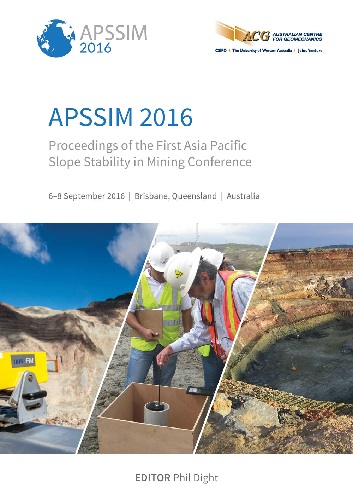Wireless low power real-time solutions for tailings dams — a case study

|
Authors: Abancó, C; Falgàs, E; Payàs, B; Pérez-Arcas, J; Scott, P |
DOI https://doi.org/10.36487/ACG_rep/1604_47_Abanco
Cite As:
Abancó, C, Falgàs, E, Payàs, B, Pérez-Arcas, J & Scott, P 2016, 'Wireless low power real-time solutions for tailings dams — a case study', in PM Dight (ed.), APSSIM 2016: Proceedings of the First Asia Pacific Slope Stability in Mining Conference, Australian Centre for Geomechanics, Perth, pp. 685-694, https://doi.org/10.36487/ACG_rep/1604_47_Abanco
Abstract:
Failures of tailings dams are amongst the most hazardous incidents that can occur at a mine. Historically, 20 tailings dam failures occur per decade. Failures can originate from overloads, anomalous behaviour of the material used to build the dam (normally tailings), or from problems with the drainage mechanisms, which result in an increase of pore water pressure and, therefore, a loss of resistance. Prevention and protection are hence crucial, and real-time monitoring and improvement of dam construction are key tools for the safety management of the embankments. Monitoring with geotechnical sensors in tailings dams brings valuable information about the safety factor of the stability of the dam. The automation of such sensors permits obtaining data at high frequency and in real-time remotely, so when predefined alarm or alert thresholds are exceeded, an alarm signal is activated. LS-G6 is a wireless low power monitoring solution, consisting of a data acquisition system which collects data from the sensors and sends it wirelessly to the gateway (central station). This system has been installed in the tailings dam of the Aguas Teñidas mine (Spain) to automatically acquire data from 8 piezometers. An analysis of the quality of the radio transmission between the data loggers and the gateway, separated between 1.6 and 1.9 km, is presented in this paper. Results on the performance of the radio indicated high quality data transfer where 90 to 100% of the radio packages have been sent and received successfully. Also, data from sensors that were collected with hourly to daily frequencies are presented. Due to the automation, changes in sensor measurements were recorded that were not detected with manual readings during previous years at the Aguas Teñidas mine. The monitoring system presented in this paper provides control in real-time of the mine’s tailings dam. In addition, many other sensors may have been integrated during further phases to control mine hydrology equipment, and stability measurements of the open pit area and access roads.
Keywords: tailings dam, wireless, monitoring, risk assessment
References:
Alonso, EE & Gens, A 2006a, ‘Aznalcóllar dam failure. Part 1: Field observations and material properties’, Geotéchnique, 56(3), pp. 165–183.
Alonso, EE & Gens, A 2006b, ‘Aznalcóllar dam failure. Part 3. Dynamics of the motion’, Geotechnique, 56(3), pp. 203–210.
Davies, MP, Dawson, BB & Chin, BG 1998, ‘Static Liquefaction Slump of Mine Tailings – A Case History’, in Proceedings of the 51st Canadian Geotechnical Conference, Edmonton.
Göransson, T, Benckert, A, Lindvall, M & Ritzén, R 2001, ‘Dam failure at the Aitik mine: Investigations, conclusions and measures taken’, in Proceedings of Securing the Future: International Conference on Mining and the Environment, Skellefteå, Sweden (appendix).
Haile, JP 1997, ‘Discussion on the failure of the Omai Tailings Dam’, Geotechnical News, vol. 15, no. 1, March, pp. 44–49.
Hinman, P 2015, Green Left Weekly, No. 1079, 8 December 2015: 16 ISSN: 1036-126X.
Martínez-Santamaría, JM, Olalla, C, Asanza, E & Díez, JA 2008, Aplicación conjunta de la guía técnica nº3, de la I.T.C. 08.02.01 del reglamento general de normas básicas de seguridad minera y de la NCSE-02 en el dique del depósito de estériles “Aguas Teñidas” (Huelva); Informe Comité Nacional Español de Grandes Presas.
Solomon, M, Tornos, F & Gaspar, OC 2002, ‘Explanation for many of the unusual features of the massive sulfide deposits of the Iberian pyrite belt’, Geology, vol. 30, p. 87–90.
Strydom, J & Williams, A 1999, ‘A review of important and interesting technical finding regards the tailing dam failure at Merriespruit’, SAICE Journal, 41 (4), pp. 1–9.
Tailings.info n.d., Merriespruit Tailings Dam Failure, Virginia, South Africa.
Tornos Arroyo, F 2008, La Geología y Metalogenia de la Faja Pirítica Ibérica, Revista de la sociedad española de mineralogía, 10.
Vanden Berghe, J-F, Ballard, J-C, Wintgens, J-F & List, B 2011, ‘Geotechnical Risks Related to Tailings Dam Operations’, in Tailings and Mine Waste 2011, Proceedings of the 15th International Conference on Tailings and Mine Waste, Norman B. Keevil Institute of Mining Engineering, University of British Columbia.
© Copyright 2025, Australian Centre for Geomechanics (ACG), The University of Western Australia. All rights reserved.
View copyright/legal information
Please direct any queries or error reports to repository-acg@uwa.edu.au
View copyright/legal information
Please direct any queries or error reports to repository-acg@uwa.edu.au